Born in 1996, in Louisville, Kentucky, Matthew Rivera is making jazz vibrate to new audiences in many ways. I met him first as a sound-phenomenon on the radio: who was this young man playing rare hot music from 78 rpm discs he treasured, and offering wise commentary?
He started “Hot Club” 78-listening sessions in New York jazz clubs, regularly at Café Bohemia in Greenwich Village, New York, then founded the Hot Club of New York, which has free Monday-night Zoom sessions, he continues to broadcast; he gives erudite yet relaxed presentations of jazz for the New York Adventure Club, and has a book in progress.
Michael Steinman: Did jazz hit you like a conversion, or was it a gradually growing fascination?
Matthew Rivera: Both. We’re fascinated when music catches us off guard, but we’re converted when we return to it. For instance, I first heard Billie Holiday’s “Did I Remember” on a movie soundtrack and I was smitten, but my ear truly changed after I sought out the recording and heard it again and again. I try to balance my love for the familiar with fascination for the unfamiliar, though often the familiar wins out. To use Amiri Baraka’s phrase, we have to “Keep Digging.”
Was there jazz on the family soundtrack when you were growing up?
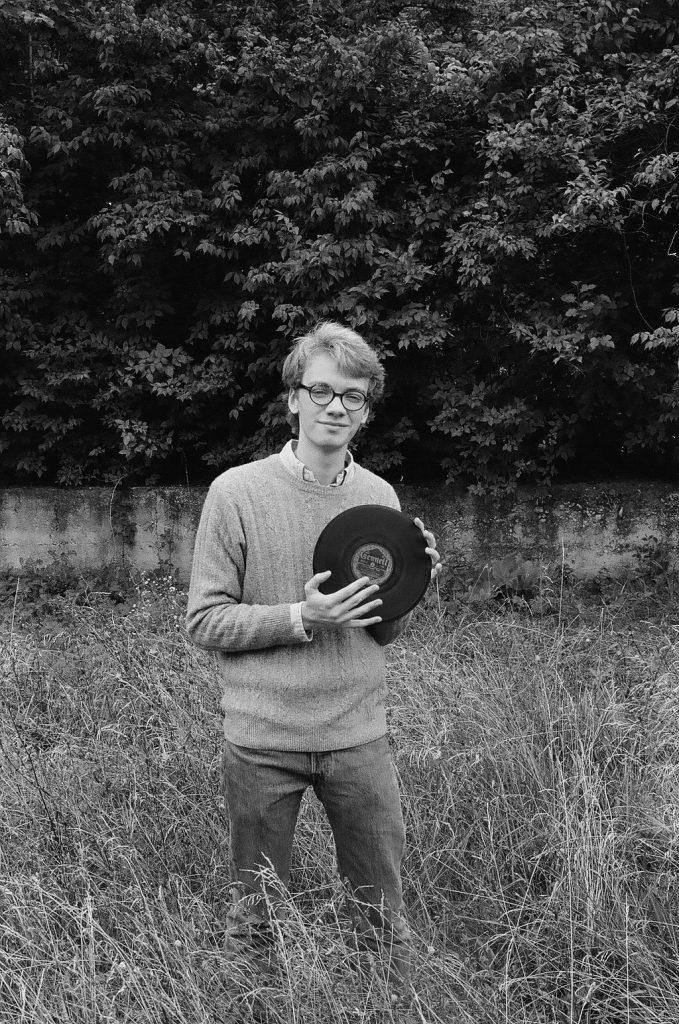
There were only scraps of jazz to hear or see in my youth. Maybe I’d see something in a movie, or hear a blues based tune on the oldies station. That truly sad fact indicates jazz’s position in our contemporary world. Somewhere we lost sight of the ongoing struggle for jazz’s power. The incredible thing you have to stress about jazz history is that in 1938 everyone was listening to jazz. Whether you wanted to or not, or even whether you knew it or not, in 1938, near a high point in the industrialization of music, it was impossible to escape an essentially non-conformist music that spoke about the conditions of life in America.
That didn’t happen simply because people liked jazz then or because it was a new thing, it happened because of the tough fight the musicians put up to be seen and heard. What we may have forgotten is that this struggle, like all social struggles, is recurring. The fight for jazz was obviously not won forever in 1938. On every level—socially, economically, in essence politically—the situation today is completely different from the height of jazz’s popularity. We have to change our strategy. I have no prescription for how to change things, but I spend a lot of time thinking, “How did we get here?”
I first encountered you as a disembodied voice, broadcasting music rarely if ever heard in public, such as Red Allen’s 1935-36 delights, on an afternoon jazz program on Columbia University’s WKCR-FM, in 2017. How did you get there?
I arrived at Columbia in 2014 with the music of Jelly Roll Morton and Coleman Hawkins stuck in my head. My friend Evan Sennett and I had just made a movie in Louisville about two friends of ours who are searching for a fictional jazz musician, and I added in lines like, “I like Prez better than Hawk.” It was just a complete fantasy about my friends also liking jazz from the ’30s.
I was walking around campus on the first day thinking “I bet no one here knows who Bunny Berigan is,” having no clue about the incredible jazz legacy of Columbia’s radio station or that I was standing on the sundial in the middle of campus where Red Allen had once played.
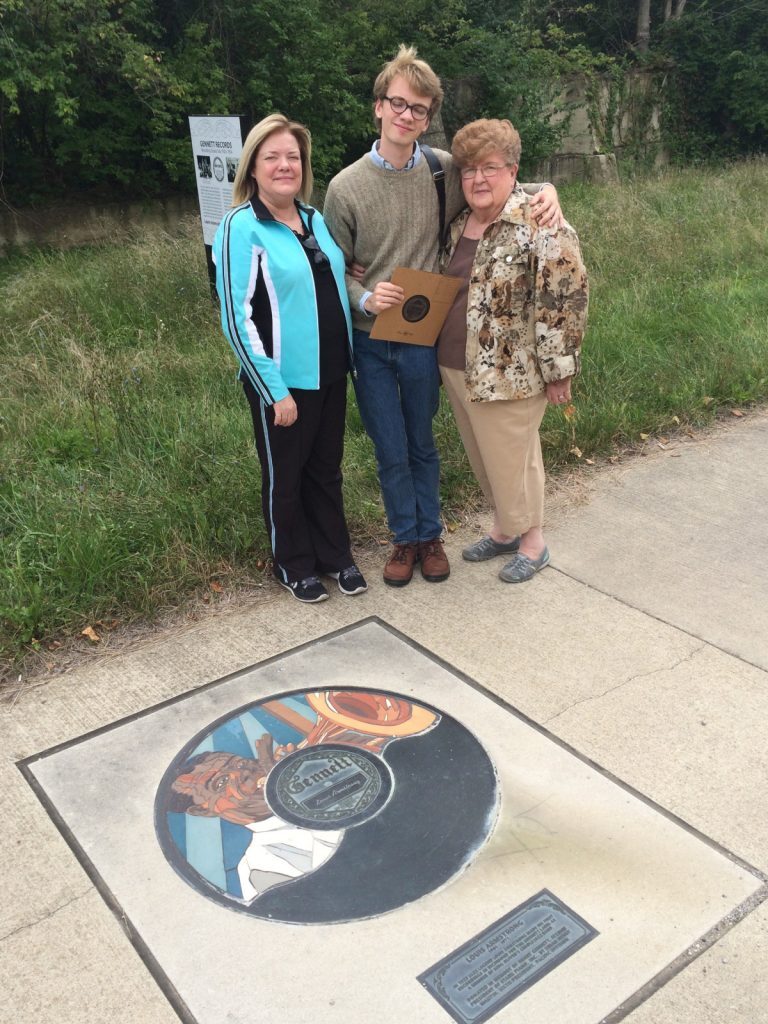
Then someone approached me with a box of LPs to promote WKCR. The first thing I saw was a Bunny Berigan record. When I picked up my jaw, I found out where WKCR was, and there I eventually met the great Charles Iselin who was hosting a multi-part show on Red Allen. Shortly thereafter, a tall, boisterous man in a seersucker suit and pink socks appeared and did a voluminous impression of Red Allen driving his car around Times Square, said a few things about the California Ramblers, made a point about Tommy Ladnier that trailed into Muggsy Spanier, and then stormed out of the station to catch the subway. When I caught my breath, Charles told me that was Phil Schaap.
I went to Columbia to study film, though I ended up studying English and anthropology instead because of professors like Ann Douglas, Brent Edwards, and Robert O’Meally who incorporate jazz heavily into their literature courses and teach cultural history. My love for jazz came about initially from movies. My parents wisely took me to see The Aviator when I was eight and I remember being affected not only by the planes and movie cameras, but by the jazz age soundtrack.
Later on I saw Anatomy of a Murder one summer at the Palace Theater. After I saw Duke Ellington in that film and heard the truly “noirvana” soundtrack, I went to Highland Records in Louisville and asked if they had any Ellington LPs. They didn’t have any, which only added to my curiosity. I felt provoked to hear the music whenever I could.
When I showed up at WKCR, I already loved jazz, but I didn’t quite yet realize its importance or vastness. That came from Phil Schaap and older students like Charles Iselin, David Beal, and Francis Mayo. Suddenly I was thrown into a tradition of 24-hour birthday broadcasts, memorial broadcasts, morning listening sessions, five-hour profiles, and discographical inquiries.
I came to the station thinking “Star Dust” by Louis Armstrong, “Easy to Love” by Teddy Wilson and Billie Holiday, “Burgundy Street Blues” by George Lewis, and “If I Were a Bell” by Miles Davis were all I would ever need to know and now I’m seeing Charles spinning these heavy, fragile 78s and listing off personnel and dates from fat red volumes.
Early on, Fran Mayo organized a caravan—three vans of students—to drive to Bessie Smith’s grave and pay our respects. Not long after that the Norwegian solographer Jan Evensmo showed up at the station. Charles and I spent the day listening to rare Roy Eldridge airshots with him that only exist at the station. I learned about the station’s efforts to save Eldridge’s collection when it washed up on the beaches of Far Rockaway during Hurricane Sandy. I heard Schaap’s 45- minute mic breaks, I learned about the Dizzy Gillespie red chair, I saw the thousands of interview reels in the vaults. I was in the middle of complete and total love for music which up to that point I had only known in solitude.
Ultimately what amazed me about WKCR was what I would learn more formally from Phil Schaap when he became my mentor without me even realizing it. First, I learned from him that all music is present tense and not to get caught up in ideologies about progress or overvalue either the future or the past. Secondly, I learned not to be a swing chauvinist or a Bebop chauvinist. One of the most beautiful traditions we have on WKCR is our back to back Ornette Coleman and Bix Beiderbecke birthday broadcasts and I have learned, albeit rather belatedly, to love both dearly.
Ultimately, I learned that music has a social and political function, and this, and the biographies of musicians, is inseparable and essential to understanding the sounds I loved. I learned from friends at WKCR and my teachers at Columbia to hear the essential spirit of the music’s makers. I learned to appreciate the very real connections that popular taste and criticism have largely overlooked. I learned that tastes are mutable, therefore I can’t let my taste or the taste of others guide my ears or changes my direction. I learned to follow musical daring.
For those who don’t know Phil Schaap, who is he?
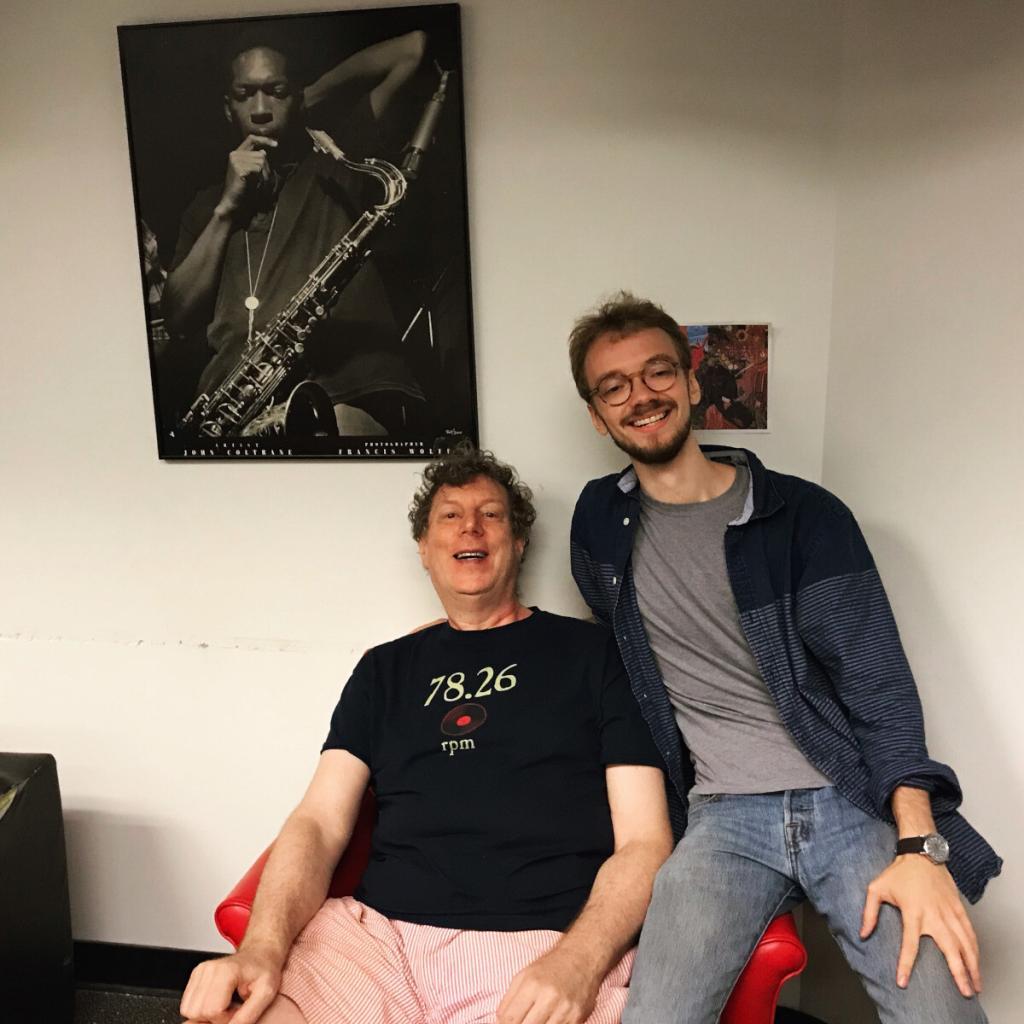
Phil is a radio host, educator, sound engineer, and historian—simply a worker for jazz and the hardest working person I’ve ever met. There is an unbelievable passion in the man who speaks on air for 45 minutes straight listing record personnel, dates, and Dodgers scores by heart, remembering what he ate when he met Duke Ellington, flipping, cuing, EQing, and playing a 78 in a matter of seconds, excerpting the eight-bar Chu Berry solo and playing it twenty times in a row, working for jazz like he is running a lifelong marathon.
What he teaches is basically music appreciation, not performance. Phil has aimed to get musicians better gigs, to teach listening to experts and newcomers alike, to introduce new generations of listeners to jazz, and to make jazz sound better through high quality sound productions.
I never would be able to learn as much as I have without Phil because he taught me how to find the music, not just to settle with what I already knew. Because of his unusual methods and his aversion to mediocrity, people like to imagine Phil as a modern version of Balzac’s Père Goriot: a tragically misunderstood artifact from a different world. But Phil became a friend, a mentor, and my main influence because his mission is to bring people to jazz. He showed me what work needed to be done, and what a worker for jazz should be.
The other person I have to explain and give a big shout out to is CHARLES ISELIN! When I met Charles, I was interested in 78s because I had seen Crumb and was curious about the records in that movie. I’m a collector at heart and I don’t think that’s a shameful or embarrassing thing if the collector reflects upon him or herself, reads some Walter Benjamin, and remembers to shower once in a while.
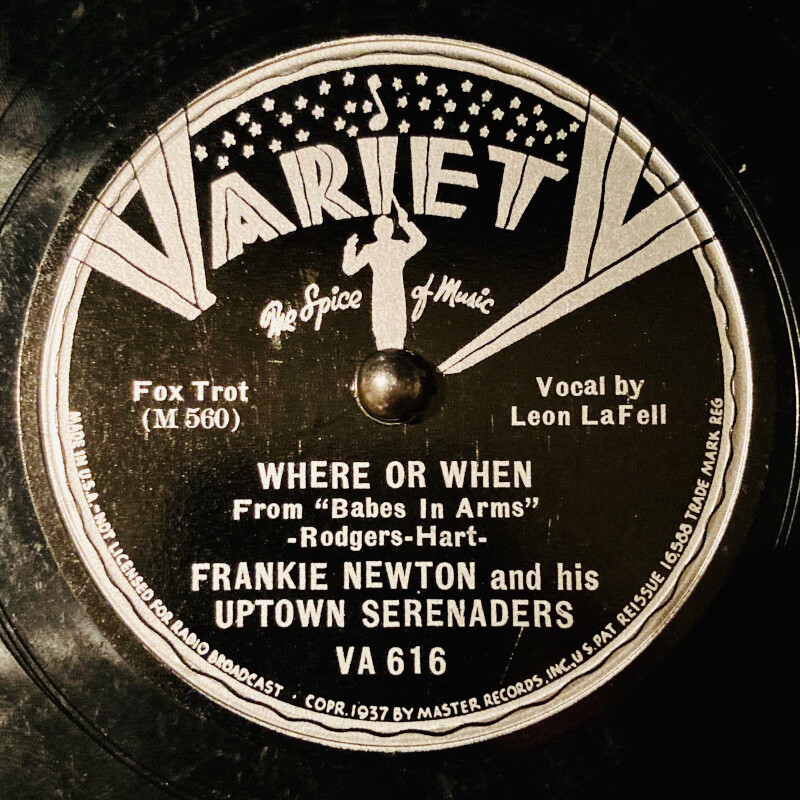 I asked Charles if he had any 78s and he went back to the archive and hauled out a box of records he had just bought. Flipping through the stack, I noticed “Who” by Frankie Newton on Bluebird, not because of Newton, who is now my hero, but because of Mezz Mezzrow, whose book Really the Blues I had just read and loved! Charles grinned and put on “Who.” I think that devil knew I was about to get hooked on some deep s*** because sure enough that night I went on eBay and bought a Red Allen Vocalion though I didn’t even have a way to play it. He showed me that the 78s were the closest I could get to the music.
I asked Charles if he had any 78s and he went back to the archive and hauled out a box of records he had just bought. Flipping through the stack, I noticed “Who” by Frankie Newton on Bluebird, not because of Newton, who is now my hero, but because of Mezz Mezzrow, whose book Really the Blues I had just read and loved! Charles grinned and put on “Who.” I think that devil knew I was about to get hooked on some deep s*** because sure enough that night I went on eBay and bought a Red Allen Vocalion though I didn’t even have a way to play it. He showed me that the 78s were the closest I could get to the music.
What led up to your founding the Hot Club of New York, whose central purpose is offering listeners “a chance to hear scarce records in their historic and aesthetic contexts, and to discuss jazz in a relaxed environment”?
Remember, I’m a filmmaker who likes jazz, but slowly there were events that led to the Hot Club. I met Parker Fishel and David Beal, two righteous fellows who loved the music, and particularly loved the Blues which was always the heart of it. That’s the main thing: the Blues is the spirit and when jazz loses the Blues, jazz loses the spirit. Everyone from Freddie Keppard to Cecil Taylor knew that. So I know that anyone who loves the Blues, like Parker and David do, is going to be a friend.
Parker invited me over to his place to listen to Pete Brown records, and David and Ben Young showed up too. That was the first Hot Club I went to, and the beginning of the Neo Hot Club Movement. I’d never had that experience, other than with Charles, of listening to the music deeply and quietly, and lovingly. That’s the experience I’ve always tried to recreate with the Hot Club, whether it was at a dressed up cellar in the Village or on Zoom on Monday nights.
They call you “Fat Cat.” But you’re not a bulky plutocrat.
Yes, I hope that handle is unlike me in more ways than one—like Tiny Parham. That really gets us to the first official Neo Hot Club: Morristown, hosted by Melissa Jones. Phil, Ben, Charles, Emily Fenster, Sam Engel, and a whole bunch would drive or ride the train out to Morristown, New Jersey, to listen to rare 78s on a top of the line sound system. I still didn’t have a turntable or anything at that time. I was only listening to my 78s at WKCR, which didn’t sound as good as at Melissa’s.
On the ride back from Morristown once, Phil mentioned a Sippie Wallace 78 of which he had only known two copies to exist. There was his, and there was Johnson “Fat Cat” McRree Jr.’s, a collector and jazz festival host from Virginia. I was shocked because I had just bought the record for $8 on the internet, only it had a sizable dig in the grooves near the end. So the next time we went out to Morristown, I brought the Sippie Wallace record and showed it to Phil.
It was the first time I had ever seen him impressed by anything. He was sweating, his eyes were bulging like a Crumb cartoon, his voice was cracking, and he told me to put on the record which I’m already in the middle of doing. As we were all listening to this unbelievably emotional, soulful blues record with Louis Armstrong and someone who wants to sound like Bechet, it gets to the chip in the grooves and Phil goes absolutely berserk, stands up in his chair, his face red, shouting “That’s Fat Cat’s copy!! You’re the Fat Cat! Fat Cat Rivera.” I had bought Fat Cat McRree Jr.’s copy for eight dollars.
You took piano lessons for ten years: tell us your James P. Johnson story.
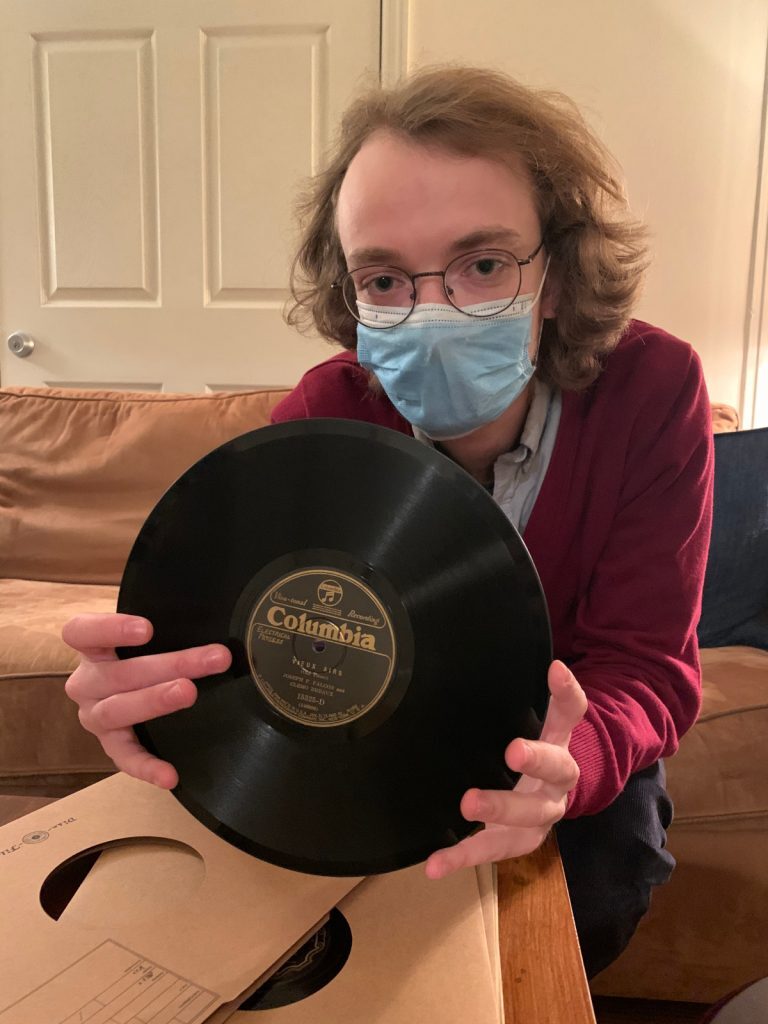
My first encounters with music were encounters with the piano. My uncle and grandmother both played and inspired me to play. I took lessons with a true friend: Calvin Pinney, a kind, churchgoing woman who would not stand for rushing or fast tempos and would have no deviation from the notes on the page. I still have her look of “You didn’t practice, did you?” burned into my mind.
I took lessons up to the point where I was playing Bach two-part inventions and the four Gershwin preludes pretty solidly. Then I found a transcription of James P. Johnson playing “If Dreams Come True.” I listened to that music non-stop, I tried to play it, and it basically broke me down completely. I realized then, I can read music, I can interpret the old masters, I play the Rodgers and Hart songbook at a party for tips, I can even slide into Gershwin, but I can’t do THAT. I realized I was an audience member.
It’s obvious you aren’t traveling this rocky road alone.
I learn from my peers, and it’s here I must thank Colin Hancock, the single most important jazz scholar living today and one of my best friends. Vince Giordano has helped me quite a bit, and with his working orchestra, The Nighthawks, he has shown us all the power of the jazz age ten piece big bands. I didn’t realize it until about ten years later, but one of my first introductions to jazz, watching The Aviator, was an introduction by Vince Giordano who performed most of the music for that film. Not to lift the curtain, Michael, but you are also an important peer and friend.
Al Vollmer, David Sager, Ricky Riccardi, Scott Wenzel, Jan Evensmo, Lloyd Rauch, Andrew Oliver, Scout Opatut, Evan Arntzen, Lucy Yeghiazaryan, and countless others have taught me more than a thing or two about jazz. Still the people I learn the most from are my close friends Sam Fentress, Alex Garnick, Evan Sennett, Aaron Friedman, Laura Cadena, and Sophie Kovel, and most importantly my love, Elena Burger.
They are all tuned in to our generation. They understand what the Hot Club mission is about and the sociality and politics of art and history. In their own individual ways, they are all non-conformist thinkers which is what I want to be. Then there’s the rarest of them all, a non-conformist thinker who understands jazz: my professor Ann Douglas who wrote Terrible Honesty and has guided me in everything from Charlie Parker to Raymond Chandler. She is someone I am honored to say is my friend.
How does jazz fit into your other passions—politics, film, American culture? Are there connections between Charlie Johnson and your literary heroes?
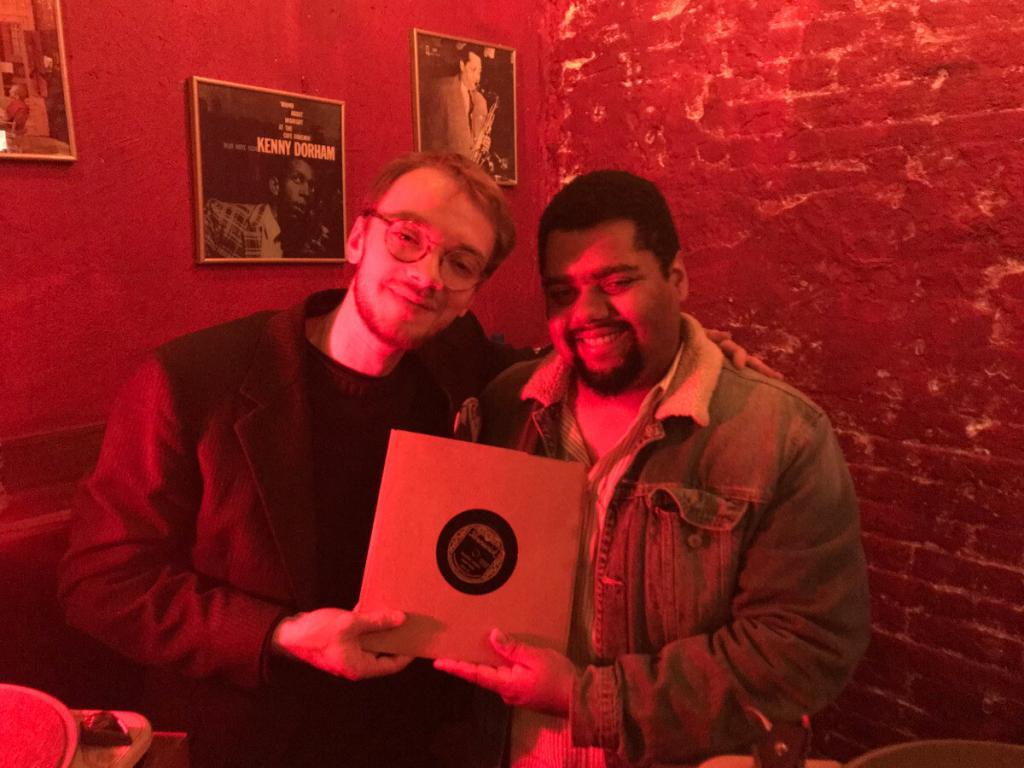
Jazz is the most specific of these topics because it relies essentially on an attitude and outlook towards life. It is the best part of American culture, but it is obviously not all of American culture. The outlook is, plainly enough, the Blues outlook—an honest square look at all of life’s nasty stuff that is deeply hurt by it and still finds a way to laugh it off, to see light not only at the other side of the tunnel but in the tunnel itself.
Though not always successful at looking, or at laughing, and not always the most approachable thing, if you judge jazz at its best (as we should always judge) it’s the only light. I appreciate other music through jazz—certainly Cuban son, Puerto Rican plena, Old Time mountain music, Cajun, gospel, Dominican merengue, Hawaiian hula, Bach, Bob Dylan, West African palm wine, Greek rebetika—but I’ve learned I basically appreciate everything that has the Blues outlook.
Outside of jazz, film noir and noir literature have been the strongest expression of this Blues spirit. The spirit, of course, predates the modern Blues as well, and it can be seen in the novels of Balzac and the poems of Sappho. Although Charlie Johnson, as a person and artist, was basically nothing like David Goodis, they both dug into the Blues with a feeling, as a song by Duke Ellington is titled.
How did you get from being “A 78 record collector” to founding the Hot Club of New York, and what do you see as its future?
Through the path people like Phil, Charles, Melissa, David, and Parker have shown me, I have seen that jazz is a social phenomenon. There’s a book called Musicking by Christopher Small which says the music is more than the object on stage, but the entire social interaction, the space, the love and the people. Dancing, record collecting, record listening, and most certainly performance attending are all acts of musicking with almost as much importance for the social space as the performance itself.
This way of understanding music is lost on us. Generally, we have lost sight of the need for an audience. If there are more musicians on stage than audience members in the house—which I’m sad to say I have witnessed—then it’s only public practice. I realized the same thing about collecting the records. If I’m only playing them for myself I’m not getting them all they’re worth. Even having the 78s is only half the battle. I’ve got to play them for people, and I have to find people who want to listen and teach more people to want to listen. The ultimate mission of the Hot Club is to introduce a new audience to jazz, and to create a space of active jazz musicking.
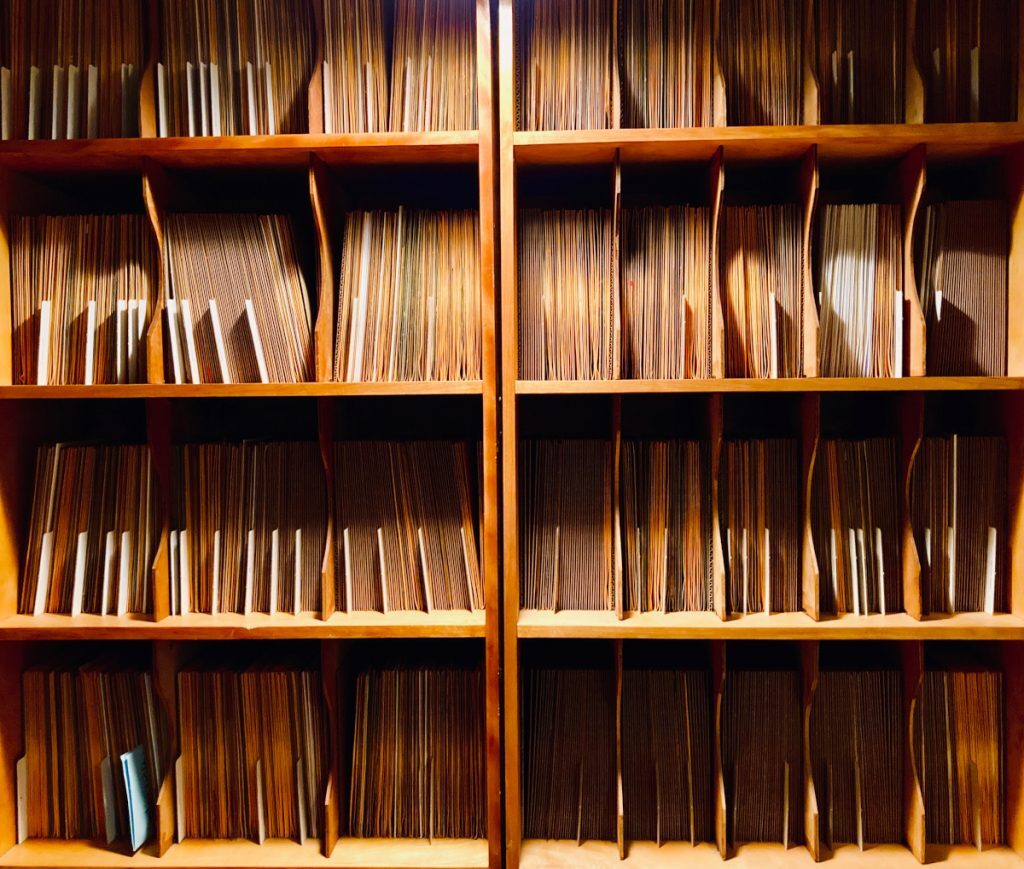
Melissa Jones, whom I first met as a classmate at Jazz at Lincoln Center’s Swing University, basically lives this idea of music, supporting and bringing together the jazz community in any way possible. I’ve already mentioned the Hot Club of Morristown. Melissa would host young musicians and listeners at her house, feeding all of us to the gills. It didn’t matter who we were as long as we loved jazz. I think the most important part of the Neo Hot Club came from Melissa as she constantly reminded me of jazz’s ultimate cause: to bring people together. She exemplified an angel of musicking to a generation of young jazz people, and when the future hit all too soon this year I took her cue to begin hosting Zoom Hot Club meetings on Monday nights. Her presence there has continued to bond the group of listeners from all backgrounds. I dedicate this interview to Melissa Jones.
What are some prizes of your collection? Do you have desert island discs?
Well, assuming I can take a ship the size of the Titanic to the island…. My number one is “Out of Nowhere” by Coleman Hawkins with a stunning muted trumpet by Benny Carter on HMV.
I’m also grateful to say I have a mint copy of Cecil Scott’s “Lawd, Lawd” on Victor, King Oliver’s Creole Jazz Band’s “Chattanooga Stomp” and “Camp Meeting Blues” on Columbia, Chick Webb’s “If Dreams Come True” on Columbia, Jack Purvis’s “Down Georgia Way,” Charlie Johnson’s “Charleston is the Best Dance After All,” both takes of Louis Armstrong’s “Star Dust,” Armstrong’s “Struttin’ With Some Barbecue” on OKeh, a west coast pressing of Art Karle’s “Lights Out” with my favorite Frankie Newton solo, “Tell Me, Dreamy Eyes” by Perley Breed’s Shepard Colonial Orchestra on Gennett (thanks to Colin Hancock), “Wipe ’em Off” by the Seven Gallon Jug Band, “Noah’s Blues” by Cannon’s Jug Stompers, “Ice Freezes Red” by Fats Navarro, “My Baby’s Blues” by the Blues Man on Juke Box, a vinylite pressing of Coleman Hawkins’s “Talk of the Town,” a vinylite of “Bird of Paradise” on Dial and my favorite Charlie Parker “Thriving on a Riff” on a beautiful sounding vinylite Savoy.
Every record I own is one I could never part with! A test pressing of “With a Smile and a Song,” an unissued side from a Teddy Wilson session with the beautiful singer Sally Gooding and the tenor great Chu Berry, is a crown jewel.
Does record collecting feed the music or vice versa?
Through collecting records I came to understand that there are alternative ways to listen to and find music. Jazz came to have a context, and context is never icing on the cake. Context is always the thing itself when you get down to it. We’ve lost sight of that fact through the current ways of distributing music, and that’s why I think we are left with an understanding of music that is supporting an ideology that handicaps the music and strips it of its active life.
Jazz is not an abstract music just like Pollock and Krasner were not abstract painters. Pollock painted about the censorship of the cold war; he danced around the oppressors to say exactly what they were afraid art was capable of saying, which is what the jazz musicians he was listening to had already done. Jazz musicians danced around power to create something seemingly nonsensical to the unhip, but explicitly communicative to its righteous audience.
Spotify, YouTube, and all of the current ways of distributing music decontextualize and deactivate music. The way these apps envision music shows exactly where those in power want it to be: in the background. Ironically, their outlook inadvertently acknowledges the importance and power of jazz. It’s our way out.
You’ve been doing intriguing research on Frankie Newton. Why is he a hero?
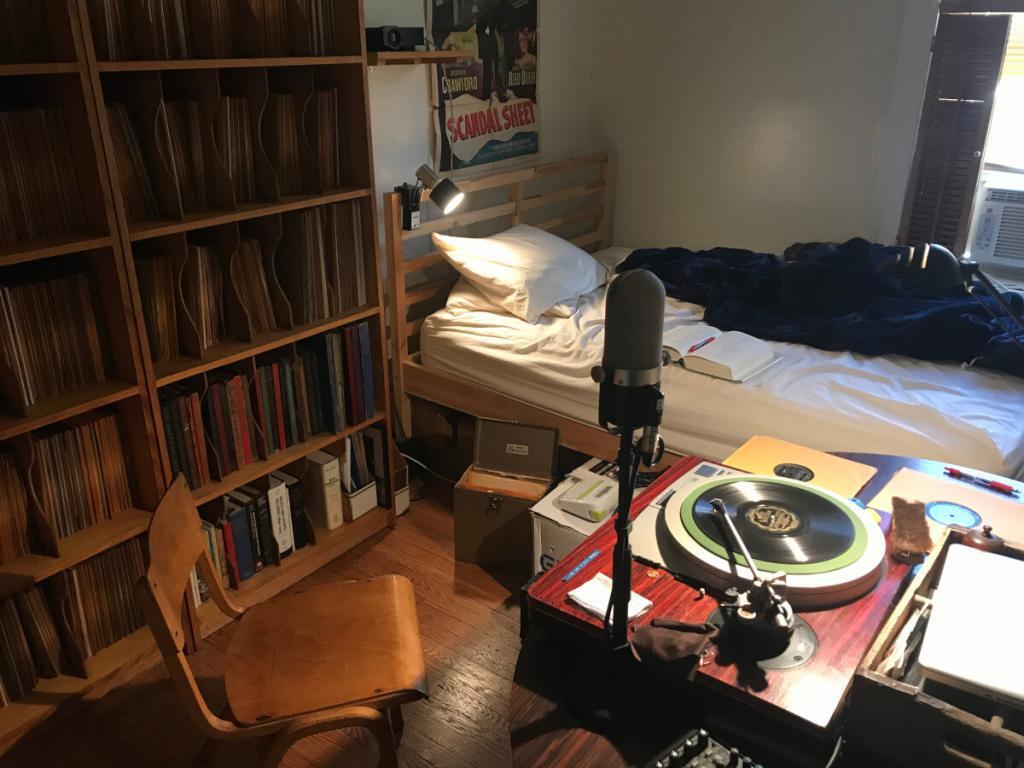
Frankie Newton is important to me because he was on the first 78 I heard, and he has since become more important to me because he showed me the way to the music. For someone who was dead for over forty years before my birth to show me the way is nothing short of the ultimate vision of jazz’s power.
The same can be said of Louis Armstrong, John Coltrane, Duke Ellington, or Billie Holiday, but for me Newton has had the loudest voice because whenever you find him, he is never caught up in the zero sum game of the culture industry, playing hide and seek to make a living and still not lose his soul. Perhaps Coltrane equals him in this regard. Newton was politically minded, but even before I knew about his politics I knew about his activities as a painter.
As someone who was balancing playing jazz records and making films and studying literature I found any character who delved into another medium from a jazz perspective to be fascinating and exceptional. The more I’ve learned about Newton, combing through newspapers, periodicals, and an interview disc I found in a junk shop, the more I’ve found that his position on the margins of jazz popularity shows the fault lines in our understanding of the music, and a point of view that contrasts revealingly with the more famous artists of his time.
Moreover, and most importantly, Frankie Newton is a truly great musician. He is the best kind of soloist—he speaks for the whole group when he solos, not just for himself. I’m always curious to hear what he has to say.
We feel the same way about Matthew Rivera!
Although I’ve thanked a lot of people in this interview, ultimately there are two groups of people to whom I’m most grateful. First, my parents and family in Kentucky, Indiana, Alabama, and Puerto Rico, and secondly, the pioneering jazz musicians of every generation. They are the original jazz workers, and all I want to do is work for them.
Matthew can be found broadcasting (from his apartment) via wkcr.org on Mondays 12-3 PM EST; join the Hot Club of New York at hotclubny.com ( there’s also a HCNY Facebook page) where you can find the Zoom link for his Monday night sessions from 7-10 PM. Information about his programs for the New York Adventure Club can be found at nyadventureclub.com.
Michael Steinman has been published in many jazz periodicals, has written the liner notes for dozens of CDs, and was the New York correspondent for The Mississippi Rag. Since 1982, Michael has been Professor of English at Nassau Community College in Garden City, New York. This story was originally published on Michael Steinman’s excellent blog Jazz Lives (jazzlives.wordpress.com), and is reprinted here with Michael’s permission. Write to Michael at swingyoucats@gmail.com. May your happiness increase!





















